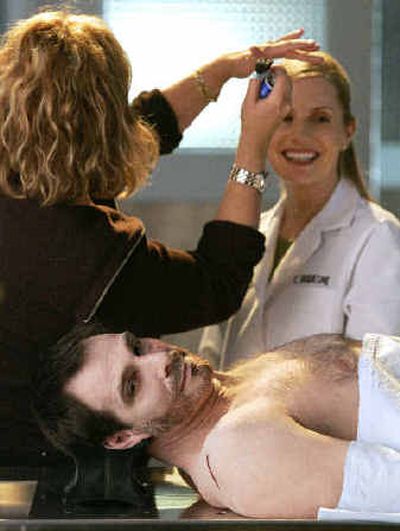Living corpses

MANHATTAN BEACH, Calif. – In the makeup trailer for “CSI: Miami,” the coroner and the murder victim sit side by side.
Vibrantly tinted lipstick and blush are applied to series star Khandi Alexander, who plays Dr. Alexx Woods. In the next chair, actress Megan Boye sits quietly as death is painted onto her face.
Delicately drawn green veins, a cosmetically induced bloodless pallor and autopsy “scars” turn Boye into an eerily believable corpse.
“Hey, everybody dies. I get to practice,” said Boye, nonchalant about her ghostly appearance as well as the morgue examination scene that awaited her later in the day.
The proliferation of “CSI” series, along with other forensic dramas, has created a graveyard full of actors who played dead. “CSI: Crime Scene Investigation,” “CSI: Miami” and newcomer “CSI: New York” do occasionally use dummy corpses, but often it’s real people who occupy the autopsy table.
Episodes for the trio of CBS’ hit crime dramas show the discovery of a victim and then flash back to the events surrounding their death. That requires a living actor.
Stiffs with the right stuff are “extremely important. That’s what people tune into, the reality of what we deliver here,” said Scott Shiffman, a “CSI: Miami” producer.
It’s the job of makeup department head Cheri Montesanto-Medcalf and her staff to fake death for “CSI: Miami” (10 p.m. Mondays).
For Boye’s character, who’s asphyxiated in next week’s episode after a sex game goes awry, an ivory-toned base sponged onto face, lips and upper chest is the first step.
The prominent veins and hidden bruising around the mouth that will show up on the autopsy table under black light add to the illusion. The victim’s body and face are well-preserved because she was discarded in a peat bog, slowing decomposition.
“They still want her to look beautiful,” Montesanto-Medcalf said of the 23-year-old actress with flowing blond hair – destined to be matted with debris.
Not bad, considering how gruesome it gets for other “CSI” victims. Photos decorating the makeup trailer at Raleigh Studios show one victim, dragged by a bus, with deep and bloody simulated abrasions. An actor transformed into a decomposed corpse is another pinup.
Laverne Munroe, helping transform Boye, created a gunshot on a squeamish actor’s face.
“He said, ‘I’ve got to step out. I’m going to throw up,’ ” recalled Munroe. “We were a little surprised. It was just a bullet hole.”
Others are far more relaxed about the process, including one cadaver who recently shared a scene with Alexander and series star David Caruso, who plays Miami police Lt. Horatio Caine.
“It was myself, David and the table between us with the corpse,” Alexander recalled. “And the guy starts snoring, loudly. In the middle of the scene. And David just turns beet red because he’s trying to get through the scene and not laugh.”
Alexander much prefers a real actor to a fake body.
“Because my character speaks to the dead, it gives me something to feed off,” she said. “A lot of our dummies don’t have faces molded; it’s just a foam body. We don’t get anything back.”
Is she ever fazed by the transformation of a performer into the violently departed?
“The only time it’s odd is during lunch, and they’re sitting there eating and their brains are blown out,” she said.
The autopsy scene with Alexander proved a snap for Boye, who had experience as a body in a short film. .
What happened to Boye’s character before she got into Dr. Woods’ tender hands was a different matter. Boye rattled off what she faced during early morning shooting at a Los Angeles area botanical garden.
“It was freezing and I die in this very skimpy lingerie,” she said. “And I’m dragged across the road and then vomited on and then buried and then vomited on again and then unburied and then laid out in a body bag in 40-degree weather,” she said.
Despite that, and the head cold she ended up with, Boye called the experience “so much fun. … I don’t get icked out easily.”
What she found difficult, besides trying not to shiver from the chill while lifeless, was a surprising empathy for her character.
“I was laying there for so long and so exposed,” Boye said. “There’s about 75 people standing around, and I’m just in my underwear, and I started to really feel like this dead body – which was very violated and very much forgotten about.”
The makeup artists take a cooler, analytic approach: Given the inventive deaths the “CSI” writers dream up, they must figure out how to realistically render a variety of corpses.
They turn to experts for help, among them David Campbell, a 23-year-veteran of the Los Angeles county coroner’s office. He’s advised a number of shows, including NBC’s “Crossing Jordan.”
Campbell admits he’s been stumped by scripts. Bogs, for instance, may be common in the Florida Everglades but aren’t part of the Southern California landscape, and he couldn’t describe how a body encased in one would look.
“If I’m asked and I don’t know, I’ll do research,” he said. “There’s a great book called ‘Spitz Fisher’s Medicolegal Investigation of Death.’ I encourage most people in filmmaking or TV to get a copy.”
Campbell takes in stride the gap between his work in the coroner’s office and Hollywood.
“One thing I have learned,” he said, “is that you tell the director what is real and the director decides what works.”